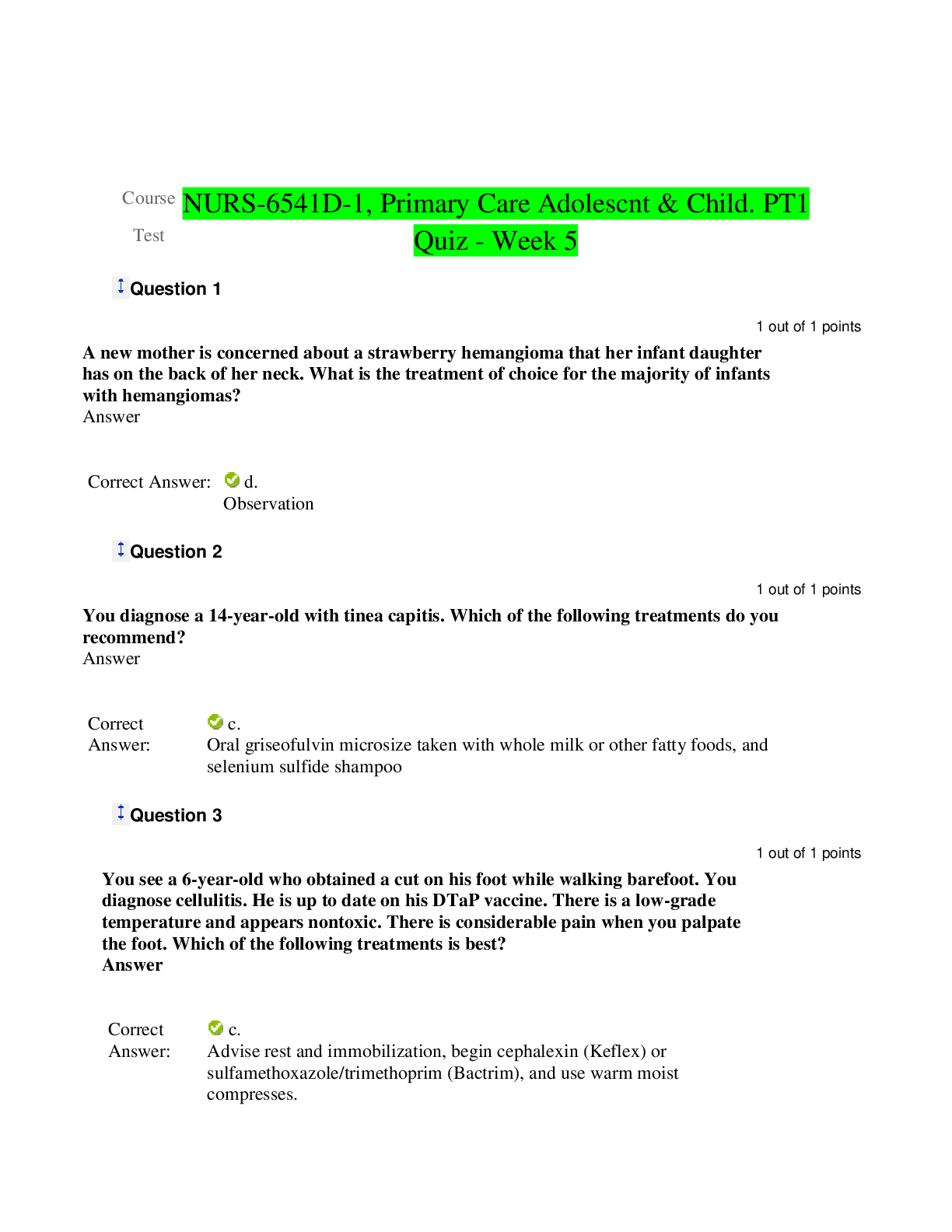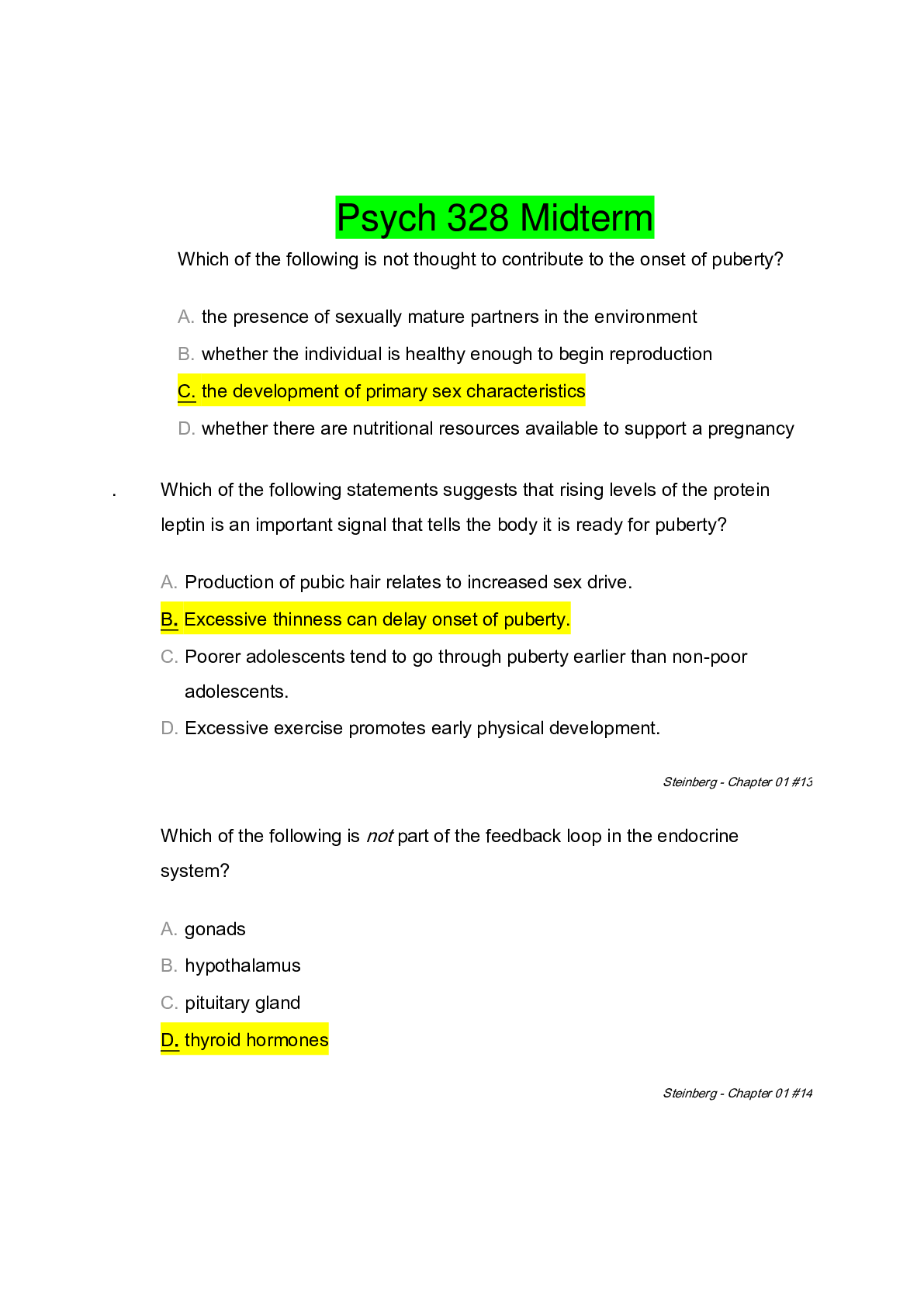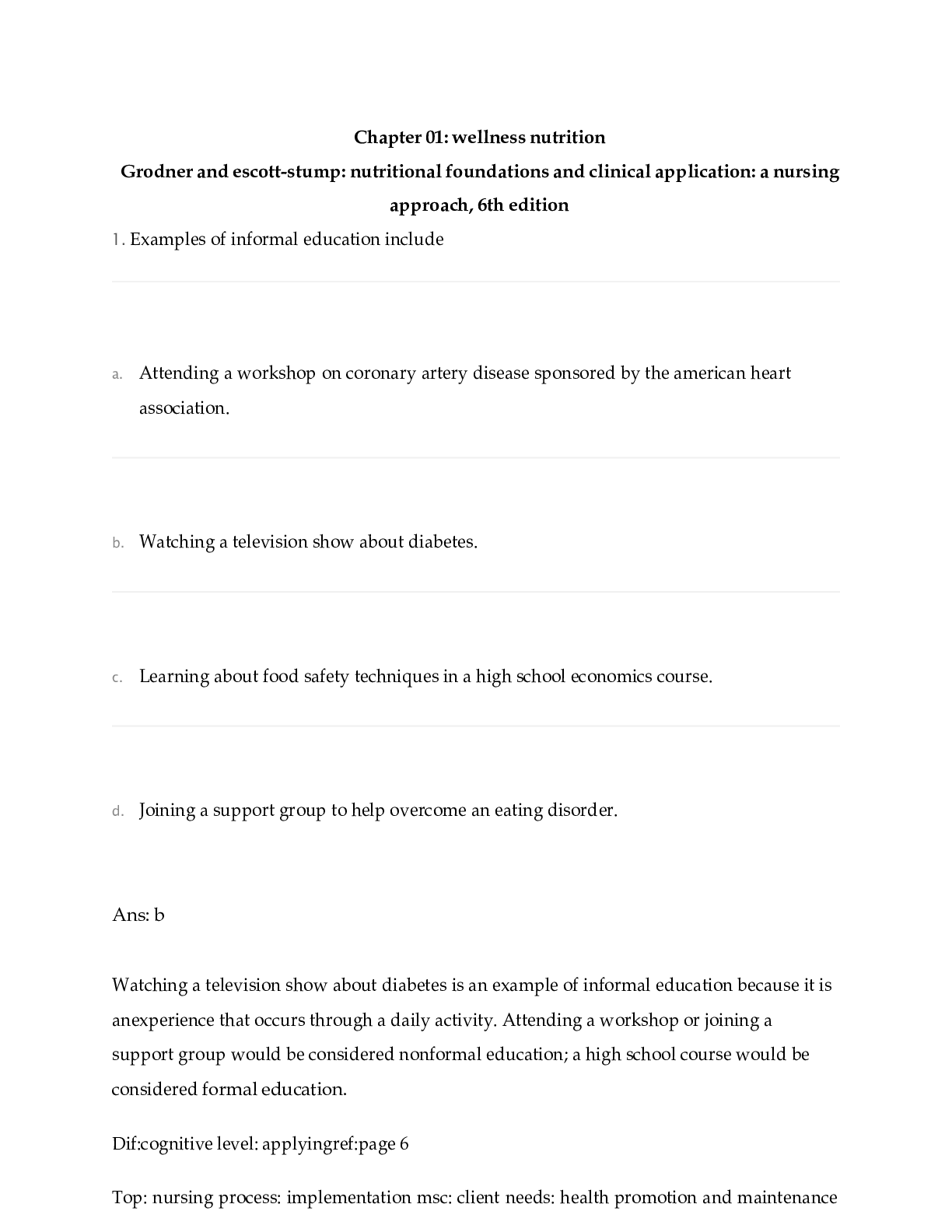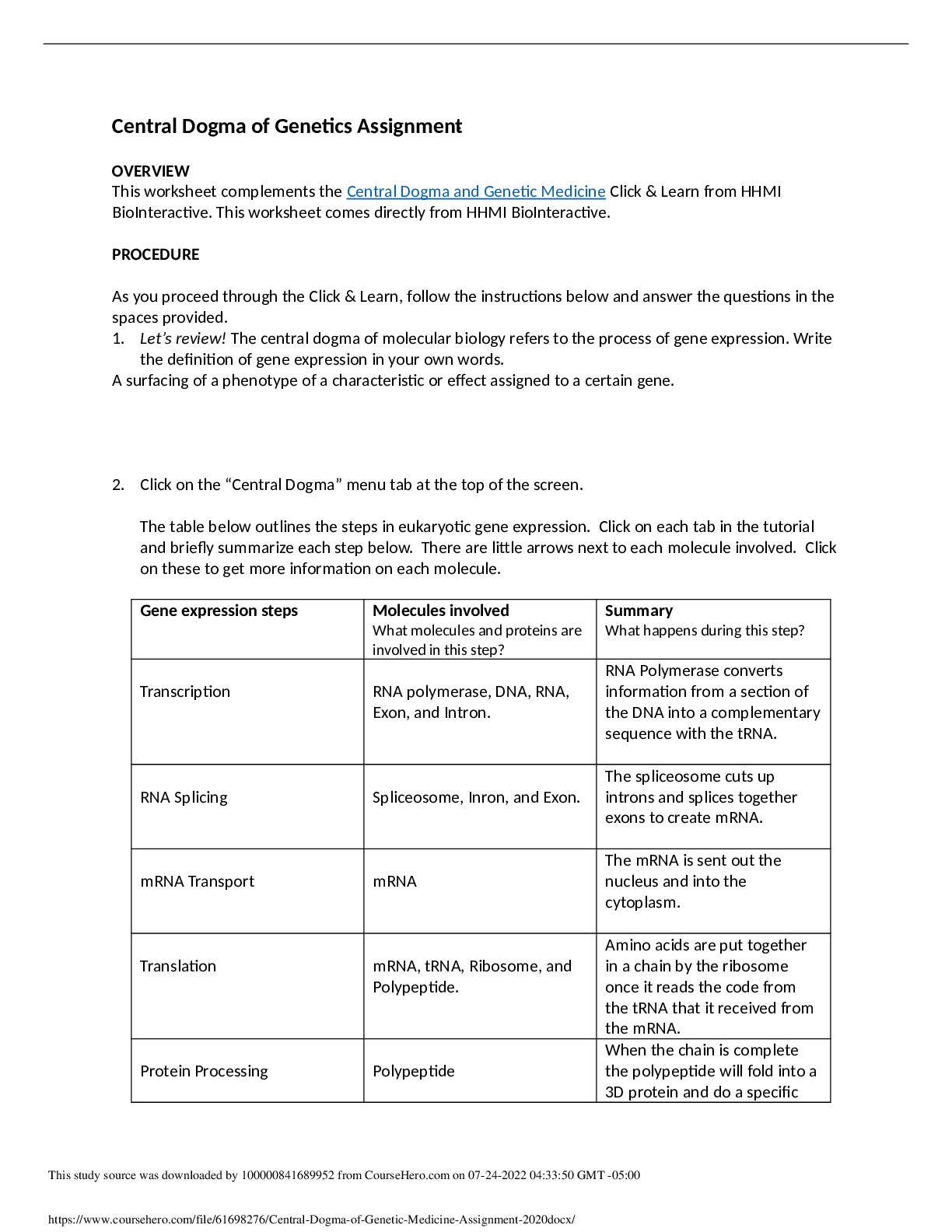*NURSING > QUESTIONS & ANSWERS > Portland Community College - BI 232SKELETAL SYSTEM II: Chapter 7: Skeletal System: Gross Anatomy UPD (All)
Portland Community College - BI 232SKELETAL SYSTEM II: Chapter 7: Skeletal System: Gross Anatomy UPDATED (ALREADY GRADED A)
Document Content and Description Below
Chapter 7: Skeletal System: Gross Anatomy Multiple Choice 1. Which of the following bones is part of the axial skeleton? 2. The appendicular skeleton consists of the 3. Which of the fol... lowing anatomical features of bones is correctly matched with its function? 4. Which of the following bones is part of the cranial vault? 5. Which of the following bones is paired? 6. Which of the following bones is a facial bone? 7. Which of the following bones is attached to the skull by muscles and ligaments? 8. Which of the following facial bones is correctly matched with its function? 9. A person who gets hit on the back of the head might suffer injury to which of these bones? 10. The sagittal suture is located between the 11. The lambdoidal suture is located between the 12. The ligamentum nuchae 13. In conduction deafness, which of the following bones might fuse together? 14. A person who has cerebrospinal fluid draining from the ear probably has a fracture of the 15. The mastoid process is 16. The cheek bone is also known as the 17. Which of the following is found inferior to the maxilla and has a posterior articulation with the temporal bone? 18. The maxilla forms 19. Which of the following bones forms part of the lateral wall of the nasal cavity? 20. Which of the following bones forms the nasal septum? 21. Which of the following bones contains a sinus? 22. The pituitary gland (hypophysis) rests in the 23. The olfactory foramina are found in the region of the ethmoid bone known as the 24. The foramen magnum is a large opening in the base of the skull for 25. Which of the following bony features is mismatched with its description? 26. The optic foramen is an opening in the sphenoid bone for the passage of the 27. Failure of the palatine processes of the maxilla to fuse properly during development results in a 28. Which of the following statements concerning the maxilla is false? 29. A person with a fractured mandible has a broken 30. Which of the following bony features is not associated with the skull? 31. The _____ region of the vertebral column is located in the neck. 32. Which of the following statements is true? 33. A traumatic hyperextension of the cervical vertebrae is referred to as 34. Which of the following is a function of the vertebral column? 35. Which of the following statements is true? 36. The coccyx is Level: 1 37. The dens or odontoid process is on the Level: 1 38. Transverse foramina are found in _____ vertebrae. 39. Articular facets on the transverse processes are characteristic of _____ vertebrae. 40. Which of the following vertebral parts is most anterior in location? 41. The loss of height that occurs with aging is due to compression of 42. The ribs articulate with the _____ vertebrae. 43. Classify a vertebra with the following characteristics: (1) superior articular processes face posteriorly (2) circular vertebral foramen (3) long spinous processes 44. A herniated disc occurs when 45. The anterior boundary of the "rib cage" is the 46. Which of the following parts of a rib articulates with the body of a vertebra? 47. Those ribs that attach directly to the sternum are referred to as _____ ribs. A) false B) vertebral C) vertebrosternal D) vertebrochondral E) floating 48. Which of the following ribs attaches to the sternum at the sternal angle? A) the first B) the second C) the seventh D) the twelfth E) the third 49. Manubrium, body, and xiphoid process are all parts of the A) pelvis. B) scapula. C) clavicle. D) sternum. E) sacrum. 50. That portion of the sternum that can be used as a starting point for counting ribs is the A) xiphoid process. B) sternal angle. C) jugular notch. D) costal notch. E) body. 51. The upper limb and its girdle are attached rather loosely to the rest of the body. This arrangement A) results in a disjointed appearance. B) limits fine coordination of the hands. C) allows a wide range of movements. D) restricts the amount of weight the upper limb can support. E) results in a limited range of motion. 52. The collar bone is the A) sternum. B) clavicle. C) scapula. D) humerus. E) atlas. 53. Another name for the shoulder blade is A) the sternum. B) the clavicle. C) the scapula. D) the acromion. E) the xiphoid process. 54. The glenoid fossa is where the A) clavicle articulates with the scapula. B) clavicle articulates with the sternum. C) humerus articulates with the clavicle. D) humerus articulates with the scapula. E) radius articulates with humerus. 55. The acromion process A) is part of the clavicle. B) articulates with the coracoid process. C) forms the most inferior part of the glenoid fossa. D) has no function. E) forms a protective cover for the shoulder joint. 56. A dislocated shoulder involves separation of the __________ from the scapula. A) radius B) clavicle C) humerus D) manubrium E) sternum 57. Which of the following is most distal in location? A) trochlea B) greater tubercle C) deltoid tuberosity D) medial epicondyle E) anatomical neck 58. The humerus articulates with the ulna at the A) medial epicondyle. B) lateral epicondyle. C) capitulum. D) radial fossa. E) trochlea. 59. If you break the lateral bone of your forearm, you have fractured your A) ulna. B) radius. C) humerus. D) olecranon. E) carpals. 60. The point of the elbow is the A) trochlea. B) capitulum. C) olecranon fossa. D) styloid process. E) olecranon process. 61. The olecranon process is found on the A) ulna. B) radius. C) scapula. D) humerus. E) clavicle. 62. In a farm accident a man has his arm severed midway between his wrist and his elbow. Which of the following bones was severed? A) radius B) humerus C) clavicle D) ulna E) A and D 63. The wrist is composed of eight A) tarsal bones. B) carpal bones. C) metacarpal bones. D) metatarsal bones. E) digits. 64. The knuckles of the hand are formed by the distal ends of the A) carpals. B) metacarpals. C) phalanges. D) tarsals. E) metatarsals. 65. A woman pinched her phalange. She hurt her A) ear. B) toe. C) cheek. D) finger. E) B or D 66. Which of the following is false? A) The wrist is the region between the forearm and the hand. B) The olecranon process is located on the distal end of the ulna. C) The distal end of the radius articulates with the ulna and the carpals. D) Tendons and nerves pass through the carpal tunnel to enter the hand. E) The radius is the most commonly fractured bone in people over 50. Answer: b Level: 2 67. The bone that articulates with the acetabulum is the A) femur. B) tibia. C) fibula. D) humerus. E) pubis. 68. The obturator foramen is found in the A) skull. B) scapula. C) sacrum. D) coxa. E) vertebrae. 69. The greater ischiadic (sciatic) notch is found on the A) inferior edge of the pubis. B) posterior side of the ilium. C) superior edge of the ischium. D) ventral surface of the sacrum. E) inferior edge of the ischium. 70. A fractured coxa is more commonly called a fractured A) arm. B) wrist. C) knee. D) pelvis. E) ankle. Answer: d Level: 1 71. A person sits on his/her A) iliac fossa. B) pelvic brim. C) pubis symphysis. D) ischial tuberosity. E) obturator foramen. 72. Which of the following situations could interfere with normal child birth? A) small ischial spines B) a small pelvic outlet C) an enlarged iliac crest D) a wide, circular pelvic inlet E) widely spaced ischial spines 73. The large bone in the thigh is the A) tibia. B) femur. C) fibula. D) ischium. E) coxa. 74. When comparing the female pelvis with the male pelvis, which of the following statements is false? A) The female pelvis is heavier. B) The ilium is more flared in the female pelvis. C) The ischial spines are further apart in the female pelvis. D) The subpubic angle is 90 degrees or greater in the female pelvis. E) The female pelvis is broader. 75. Which of the following statements is true? A) The head of the femur articulates with the tibia. B) The medial condyle articulates with the acetabulum. C) Both the greater and lesser trochanters are attachment sites for muscles. D) The distal end of the tibia articulates with the femur. E) The proximal end of the femur articulates with the tibia. 76. Which of the following is correctly matched? A) greater trochanter - distal shaft of femur B) lateral malleolus - distal end of tibia C) patella - bone within tendon of quadriceps D) tibial tuberosity - superior to the patella E) medial malleolus – proximal end of the tibia 77. The medial malleolus A) is the proximal portion of the tibia. B) forms the medial side of the ankle joint. C) articulates with the calcaneus. D) is part of the arch of the foot. E) is on the lateral side of the leg. 78. A patient in a skiing accident is told that the lateral side of the ankle joint has been crushed. The bone that has been injured is the A) femur. B) tibia. C) fibula. D) calcaneus. E) talus. 79. The tarsal bone that articulates with the tibia and the fibula is the A) talus. B) cuboid. C) navicular. D) calcaneus. E) patella. 80. The heel of the foot is formed by the A) talus. B) patella. C) cuboid bone. D) navicular bone. E) calcaneus. Level: 1 81. The foot contains A) carpals. B) a patella. C) metacarpals. D) metatarsals. E) the lateral malleolus. 82. The thumb and big toe are similar in that A) both contain carpal bones. B) each have three metatarsals. C) both are composed of sesamoid bones. D) both have two rather than three phalanges. E) both have three rather than two phalanges. 83. A woman who drops something on her foot might injure which of the following bones? A) vomer B) pisiform C) lunate D) cuneiform E) metacarpals Refer to the following figure for questions 84-88. 84. What does structure “A” represent? A) frontal bone B) occipital bone C) parietal bone D) sphenoid bone E) temporal bone 85. What does structure “B” represent? A) frontal bone B) occipital bone C) parietal bone D) sphenoid bone E) temporal bone 86. What does structure “C” represent? A) frontal bone B) occipital bone C) parietal bone D) sphenoid bone E) temporal bone 87. What does structure “D” represent? A) frontal bone B) occipital bone C) parietal bone D) sphenoid bone E) temporal bone 88. What does structure “E” represent? A) frontal bone B) occipital bone C) parietal bone D) sphenoid bone E) temporal bone Refer to the following figure for questions 89-93. 89. What does structure “A” represent? A) atlas B) axis C) body of vertebra D) intervertebral disk E) thoracic region or curve Answer: a Level: 1 90. What does structure “B” represent? A) atlas B) axis C) body of vertebra D) intervertebral disk E) thoracic region or curve Answer: b Level: 1 91. What does structure “C” represent? A) atlas B) axis C) body of vertebra D) intervertebral disk E) thoracic region or curve Answer: e Level: 1 92. What does structure “D” represent? A) atlas B) axis C) body of vertebra D) intervertebral disk E) thoracic region or curve Answer: d Level: 1 93. What does structure “E” represent? A) atlas B) axis C) body of vertebra D) intervertebral disk E) thoracic region or curve Answer: c Level: 1 For questions 94 to 98 match the following structures with the proper description. A) contains blood vessels that drain blood from the skull B) conveys sound waves to eardrum C) transmits branch of trigeminal nerve D) internal carotid artery passes through this structure E) convey tears from eyes to nasal cavity For questions 99 to 103 match the following terms with the proper description. A) this condition is also known as hump back B) results from damage to annulus fibrosus and release of nucleus pulposus C) the failure of vertebral laminae to fuse D) an exaggerated curvature of the lumbar region E) an abnormal lateral curvature of the spine For questions 104 to 108 match the following structures with the proper description. A) part of the vertebral arch B) fibrocartilage located between the bodies of adjacent vertebrae C) site where spinal nerves exit the vertebral column D) opening in vertebrae for the spinal cord E) posterior, inferior projection from vertebrae For questions 109 to 113 match the following bony features with their descriptions. A) joint between ilium and sacrum B) portion of coxa a person sits on C) large depression on medial side of ilium D) junction of two pubic bones E) anterior end of the iliac crest For questions 114 to 118 match the following bones with their common names. A) shoulder blade B) finger bones C) kneecap D) breastbone E) shinbone For questions 119 to 123 match the bony feature with the correct bone. A) fibula B) scapula C) humerus D) ulna E) femur Fill in the Blank 124. The suture that separates the two parietal bones from one another is the _______ suture. 125. The cranial bone that forms the bony eyebrow ridges and roofs of the orbits is the _______ bone. 126. The skull bone that forms the chin is also the only bone connected to the skull by a freely moveable joint. This bone is the _______ . Answer: mandible Level: 1 127. The sella turcica, pterygoid processes and the greater wings are on the _______ . 128. The first cervical vertebra is called the _______ . 129. Ribs articulate posteriorly with the _______ vertebrae. Answer: thoracic Level: 1 130. The femur articulates with the coxa at the _______ . 131. The coxa is formed by the fusion of the _______ , _______ , and _______. 132. A traumatic hyperextension of the cervical vertebrae is called _______. 133. Ribs that do not attach to the sternum are called _______ . Essay Questions 134. List the processes that can be palpated in the upper and lower extremities. 135. Which bone is involved in a each of the following? a. fracture of the shin bone b. broken knee c. broken tailbone d. broken collar bone e. shattered olecranon process f. compression fracture of the glenoid fossa g. heel spurs h. bruised breastbone i. lump on forehead j. broken toe k. cleft palate l. houses inner ear Level: 2 136. How do the structural differences of the pectoral and pelvic girdles reflect their functional differences? 137. Clearly explain how the structure of the pelvis of an adult female reflects adaptations for pregnancy. 138. Long-term bedridden patients sometimes develop decubitus ulcers (pressure sores). List three bony protuberances that might be sites for these ulcers. 139. Why is the clavicle broken more frequently than the scapula? [Show More]
Last updated: 1 year ago
Preview 1 out of 26 pages

Reviews( 0 )
Document information
Connected school, study & course
About the document
Uploaded On
Apr 28, 2020
Number of pages
26
Written in
Additional information
This document has been written for:
Uploaded
Apr 28, 2020
Downloads
1
Views
84


























.png)


.png)


.png)



